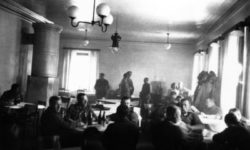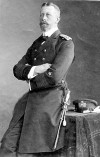Up to the establishment of the first German empire there were South German states, the Grand Duchies and the individual Kingdoms of no uniform armed force and concomitantly no uniform rank designation and structuring among the sovereigns. With most smaller principalities one oriented oneself however as far as possible at that Prussian sample. Only with the establishment of realm starting from 1871 the ranks were adapted gradually completely to the Prussian.
Allocation of the crew ranks after the establishment of realm:
- Contactor, Füsilier, infantryman, Musketier, Dragoon, Hussar, Kürassier, Ulan, Kanonier
(soldier ind the guard troop units had the rank guard Füsilier, guard infantryman etc. )
- private first classes: Coat of arms button (like Sergeanten, however in smaller diameter) on both collar sides (since 1853)
- Upper private first classes (only in the service of the foot artillery): Sergeantenknopf, Unteroffizierstroddel and/or. - bayonet knots at the bayonet (bayonet and/or. Rider sword)

Collar with large eagle button of the Sergeanten and sergeant (wikipedia.de)
Additionally there were still so-called “Freiwillige” the one 1 year old service in the army apart from the crew ranks carried out. These were marked as follows:
- One year's einjährig-Freiwilliger: turned Wollschnur in the national colors along the edge of the shoulder straps - Kapitulant: narrow Wollborte in the national colors crosswise over the lower edge of the shoulder straps; Bayonet Troddel and/or. Sword bayonet knot in national colors (similar the sergeant badge)
The designations of one year's einjähriger-Freiwilliger as well as Kapitulant were not military ranks. The badges were not put down with a possible transport however.
Allocation of the sergeant ranks without and with Portepee:
sergeants without Portepee
- sergeant and/or. Upper hunter (hunter troop): Tresse (silver or gold metal) around edge of collar and sleeve impacts, bayonet Troddel and/or. Rider sword bayonet knot in national colors (e.g. Prussia black-and-white, Bavaria white-blue), garrison cap (since 1875) - Sergeant: like sergeant, Sergeantenknopf (with impressed Landeswappen: Prussian eagle, Bavarian lion etc.) - wo1, (since 1. January 1899, before: Portepee wo1: like sergeant, Portepee at the bayonet, Offizierskokarde at the head coverage
Candidate to the career officer (since that 1. January 1899 Fahnenjunker mentioned) carried the designation (Portepee) for wo1. Vor der Beförderung zum (Portepee-)Fähnrich wurde die Mannschaftsuniform getragen. The transport to (Portepee) the wo1 was reached by an existed wo1 examination as well as at least six service months. Subsequently, the sergeant uniform with mentioned above could be carried for additional badges. After the existence of the officer examination the authorization for carrying the officer side weapon in form of a sword, sword or pistol was issued, equally the rank sergeant with Portepee was given.
sergeants with Portepee
- Vice-sergeants and/or. Vice-being awake master: like Sergeant, officer side weapon (with Portepee) to crew ouple, officer buttons, Offizierskokarde at the head coverage - (Portepee) wo1: similarly vice-sergeant, however collar without Tressen and Sergeantenknopf. Officer side weapon.
Officer over skirt with crew shoulder straps (then side weapon put at foot troops by the left skirt lap, at mounted troops under), Offizierskokarden at the head coverage - sergeants and/or. Wachtmeister: like vice-sergeants, since 1889 the first sergeants (budget-moderate sergeants) carried a second (narrow) Tresse from Metallgespinst over the sleeve impacts (the expression „piston rings “came for it however only in the realm resistance on) - Officer deputy: like vice-sergeant, Metalltresse around shoulder straps, officer head coverage
Off approx. 1893 came it then also for the first time with the sergeant ranks to the use to carry Winkeltressen from metal to the again introduced blouse-like Litewka. Thus on the left upper arm the upward open angles one carried as follows: sergeant - an angle; Sergeant - two angles; Vice-sergeant - three angles; Sergeant - four angles
The Winkeltressen was put on also by the colonial forces in the German colonies.
Officers
Subalternoffiziere
- Sergeant second lieutenant: like vice-sergeant, shoulder pieces such as second lieutenant - second lieutenant (since 1. January 1899, before: Second lieutenant): Shoulder pieces from eight flat cords lying side by side (silver), Epaulette without fraying and without star - first lieutenant (before: Prime Minister lieutenant): like second lieutenant, (squarely, more posed on the point) a golden star, Epaulette without fraying with a star
Main people and ride masters
- Captain and/or. (with the Kavallerie and other mounted units, z. B. Train) ride master: like second lieutenant, two golden stars on shoulder piece and Epaulette without fraying
Staff officers
The Epauletten of the staff officers had at the edge narrow fraying, the cords of the shoulder pieces did not lie side by side not, but was from silver flat cords twisted - major: without star - lieutenant colonel: a golden star - Colonels: two golden stars

Epauletten and shoulder pieces of the officers (wikipedia.de)
Generals
The Epauletten of the general ranks had spreads a fraying (so-called Kantillen), the shoulder pieces was twisted from golden and silver flat cords.
- Major general: no star
- lieutenant general: a star
- general of the infantry and/or. Kavallerie and/or. Artillery: zwei Sterne (as a characterized
general field marshal of additionally two crossed marshal staffs)
- Colonel general: like major general, three stars (arranged to the triangle pyramid; as a characterized
general field marshal of additionally two crossed marshal staffs)
- colonel general with the rank of a general field marshal: four stars (introduced to the square arranged, rank to 23. January 1911)
- general field marshal: two crossed marshal staffs
Colonel general with the rank of a general field marshal was a personal honour title. The honour rank characterized general field marshal lent up to then corresponded to it.
You can find the right literature here:
The German Army in World War I
The years 1915–17 of World War I saw the Imperial German Army forced to adapt to the new realities of static trench warfare. Prewar uniforms and equipment had to be modified, for both utility and economy; on battlefields ruled by machine guns and artillery the steel helmet reappeared, as well as masks to protect against poison gas. The fashionable cavalry regiments soon proved irrelevant on the Western Front; many were dismounted to join the infantry, while new types of unit usurped their prestige – assault battalions, and the air corps. This second volume in a three-part sequence offers a mass of detail on organisation, uniforms and insignia, illustrated with rare photographs and meticulous colour artwork.
Imperial German Army 1914-18: Organisation, Structure, Orders of Battle
A hardback reprint of the most complete guide to the organisation, structure and units of the First World War German Army yet published. A detailed account of the composition, structure and organisation of the First World War German Army has long been needed by English-language readers - this work fills the gap admirably. In more than 400 pages, the authors examine all aspects of the army. A detailed analytical text is followed by an extensive compendium of order-of-battle data. Topics covered include High Command & War Leadership, Composition of Army Groups, Armies, etc., Organisation of the Field Army (incl. Infantry; MG formations; Cavalry; Artillery; Pioneers; Air Force; Supply troops; Tank units; Pioneers; Signals troops; Railway & Transport troops; Medical troops; Field Gendarmerie, etc.), Organisations of the Home Front & Occupied Territories, extensive order-of-battle data, plus lists of units, army commanders & chiefs of staff. An essential First World War reference.
The Kaiser's Army: The German Army in World War One
In this comprehensive book, David Stone describes and analyzes every aspect of the German Army as it existed under Kaiser Wilhelm II, encompassing its development and antecedents, organization, personnel, weapons and equipment, inherent strengths and weaknesses, and victories and defeats as it fought on many fronts throughout World War I.
The book deals in considerable detail with the origins and creation of the German army, examining the structure of power in German politics and wider society and the nation's imperial ambitions, along with the ways in which the high command and general staff functioned in terms of strategy and tactical doctrine. Stone examines the nature, background, recruitment, training, and military experiences of the officers, NCOs, and soldiers, as well as personal and collective values relating to honor, loyalty, and conscience.
In addition the army's operations. Stone gives context with an overview of the army at war, covering the key actions and outcomes of major campaigns from 1914 to 1918 up to the signature of the Armistice at Compiègne. For anyone seeking a definitive reference on the German Army of the period--whether scholar, historian, serving soldier or simply a general reader--this remarkable book will prove an invaluable work.
The German Army Handbook of 1918
Compiled by British Intelligence, for restricted official issue by the General Staff, German Army Handbook of April 1918, is a comprehensive assessment of the German Army during the latter stages of the First World War. Illustrated throughout with plates, diagrams, charts, tables and maps, it provides a detailed breakdown of the army, covering all aspects from recruiting and training, mobilization, command and organization, weapons and signals to transportation, medical and veterinary services, and uniform. The German Army Handbook of 1918 was a remarkable achievement. It provides solutions to many questions that histories of the First World War and accounts of its battles are unable to answer. It shows how the static conventions of trench warfare usurped the traditional role of cavalry, and how the German Army were able to take advantage of the dominance of the machine-gun on the Western Front in 1915. There are also two maps, showing Army Corps Districts, and Zones of Administration and Lines of Command in June 1917. The events of 1914 transformed the armies of Europe, and made much of the information contained in the amended 1912 handbook worthless. The emergence of trench warfare created conditions in which the traditional concepts of offense and defense had little meaning. Within a few months battle conditions had created a situation in which pre-war intelligence publications had only little relevance.
Sturmtruppen: WWI German Stormtroopers (1914-1918)
The first assault units (Sturmtruppen) were formed during the spring and summer of 1916, when the Sturmbataillon Rohr was organized and after General Falkenhayn, head of the OHL, gave orders for the creation of special detachments. These detachments had the mission of spreading the Stosstrupptaktik, a new tactic which decisively transformed the fighting methods of the German Army. But long before this happened, another type of troops had been created within the German infantry during the winter of 1914-1915: the Shock troops (Stosstruppen), fresh infantry groups that were never officially recognized as such and never belonged to any permanent unit, but remained active until the end of the war and contributed to improving the offensive capacity of the German infantry.
This book is a narration of the history of the shock and assault troops and covers their combat methods. Finally, it offers a comprehensive description of their uniforms, equipment, and weapons, along with a large number of illustrations and period photographs rarely seen.
This post is also available in:
 Deutsch (German)
Deutsch (German)  Français (French)
Français (French)  Italiano (Italian)
Italiano (Italian)  简体中文 (Chinese (Simplified))
简体中文 (Chinese (Simplified))  Русский (Russian)
Русский (Russian)  Español (Spanish)
Español (Spanish)  العربية (Arabic)
العربية (Arabic)

















